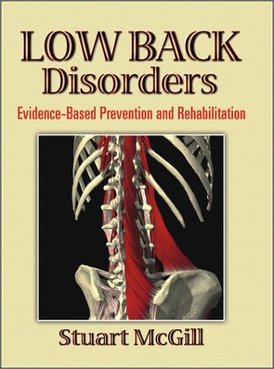 An oldie, but a goodie. This review pertains to McGill's Low Back Disorders (1st edition). It was written by Angela Regier Cubos, DC several years back, but worth the read. Low Back Disorders: Evidence-Based Prevention and Rehabilitation Stuart McGill Human Kinetics Inc., 2002 295 pages This book attempts to give the reader a more in-depth understanding of the workings of the lumbar spine as it pertains to injury and rehabilitation. It is geared towards the more academically inclined individual, with a basic understanding of the anatomy and biomechanics of the low back. The author uses the most current and relevant scientific evidence to develop rehabilitation strategies for common low back pain, while highlighting common misconceptions that are often encountered in rehabilitation. The book is divided into 3 distinct sections, each with its own focus. Part I provides a foundation for the remainder of the book by: giving an introduction to the issues surrounding low back disorders in society; highlighting the current knowledge regarding the epidemiology of low back pain; giving an in-depth description of the functional anatomy of the lumbar spine; as well as delving in to the mechanics of the lumbar spine, both in a normally functioning and injured state. Part II focuses on injury prevention strategies. Various guidelines for risk assessment are discussed that can be applied to both the occupational and/or athletic setting. The author then provides various strategies that should be employed by both the occupational worker as well as the athlete in order to reduce the occurrences of low back injuries, such as proper lifting techniques and training strategies. This section ends with an in-depth discussion of the use of back belts both in the workplace and for the athlete as a means of treating and preventing low back pain. Finally, Part III uses the foundational scientific knowledge gained in the preceding chapters to introduce rehabilitation strategies for low back disorders. This section explains how to properly assess each individual to determine the type of rehab strategies to employ, and then proceeds to explain the best exercises to use in order to train and strengthen the lumbar spine. The author provides exercises of varying degrees of difficulty in order to encompass a wide range of patients, up to, and including, the high-performance athlete. He demonstrates the need to include these exercises that provide maximal opportunity for strengthening, yet minimal opportunity for injury in any management program, and provides the research to support this. Overall, McGill does an impeccable job of presenting the reader with a concise overview of the overwhelming topic of low back injury and rehabilitation. Tackling such an enormous issue in the scientific and thorough manner demonstrated here, reserves this book for those who already have a foundation in anatomy, biomechanics, and treatment strategies for the low back. Despite the plethora of charts and experimental data presented throughout the book, the reader feels well versed at the conclusion of the text to accurately assess the low back, as well as implement safe and effective rehabilitation strategies for a wide range of patients. This book is a must-read for any manual therapist who will be encountering the common complaint of low back pain in practice. The more recent version of Low Back Disorders (2nd Edition) is available through my Amazon library by clicking on “Educational Resources” above.
0 Comments
Leave a Reply. |
